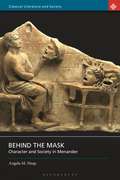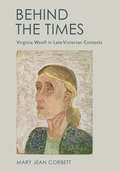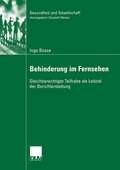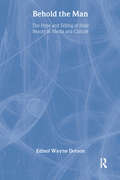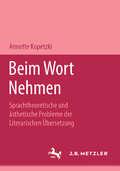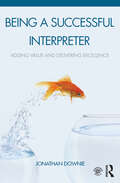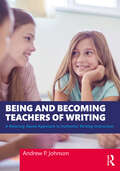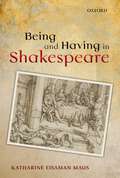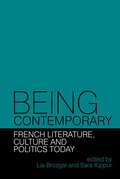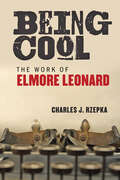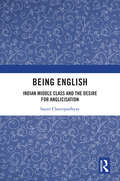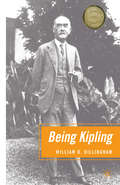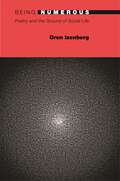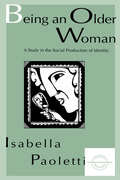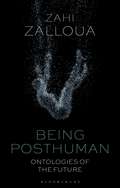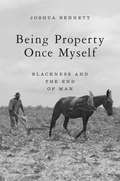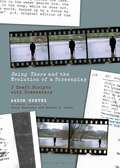- Table View
- List View
Behind the Mask: Character and Society in Menander (Classical Literature and Society)
by Angela M. HeapThis new study of Menander casts fresh light not only on the techniques of the playwright but also on the literary and historical contexts of the plays. Menander (342/1-292/1 BCE) wrote over a hundred popular comedies, several of which were adapted by Plautus and Terence. Through them, he was a major influence on Shakespeare and Molière. However, his work survived only in excerpts and quotation until some significant texts reappeared in the nineteenth and twentieth centuries on papyrus. The mystery of their loss and rediscovery has raised key questions surrounding the transmission of these and other Greek texts. Theatrical masks from the fourth century BCE discovered on the island of Lipari now also provide important material with which this book examines how the plays were originally performed. A detailed investigation of their historical setting is offered which engages with recent debates on the importance of social status and citizenship in Menander's plays. The techniques of characterization are also examined, with particular focus on women, slaves and power relationships in his Epitrepontes. It appears that the audience was invited, sometimes subversively, behind the mask of this sophisticated comedy to discover that people do not always conform to literary expectations and social norms.
Behind the Mask: Character and Society in Menander (Classical Literature and Society)
by Angela M. HeapThis new study of Menander casts fresh light not only on the techniques of the playwright but also on the literary and historical contexts of the plays. Menander (342/1-292/1 BCE) wrote over a hundred popular comedies, several of which were adapted by Plautus and Terence. Through them, he was a major influence on Shakespeare and Molière. However, his work survived only in excerpts and quotation until some significant texts reappeared in the nineteenth and twentieth centuries on papyrus. The mystery of their loss and rediscovery has raised key questions surrounding the transmission of these and other Greek texts. Theatrical masks from the fourth century BCE discovered on the island of Lipari now also provide important material with which this book examines how the plays were originally performed. A detailed investigation of their historical setting is offered which engages with recent debates on the importance of social status and citizenship in Menander's plays. The techniques of characterization are also examined, with particular focus on women, slaves and power relationships in his Epitrepontes. It appears that the audience was invited, sometimes subversively, behind the mask of this sophisticated comedy to discover that people do not always conform to literary expectations and social norms.
Behind the Times: Virginia Woolf in Late-Victorian Contexts
by Mary Jean CorbettVirginia Woolf, throughout her career as a novelist and critic, deliberately framed herself as a modern writer invested in literary tradition but not bound to its conventions; engaged with politics but not a propagandist; a woman of letters but not a "lady novelist." As a result, Woolf ignored or disparaged most of the women writers of her parents' generation, leading feminist critics to position her primarily as a forward-thinking modernist who rejected a stultifying Victorian past. In Behind the Times, Mary Jean Corbett finds that Woolf did not dismiss this history as much as she boldly rewrote it.Exploring the connections between Woolf's immediate and extended family and the broader contexts of late-Victorian literary and political culture, Corbett emphasizes the ongoing significance of the previous generation's concerns and controversies to Woolf's considerable achievements. Behind the Times rereads and revises Woolf's creative works, politics, and criticism in relation to women writers including the New Woman novelist Sarah Grand, the novelist and playwright, Lucy Clifford; the novelist and anti-suffragist, Mary Augusta Ward. It explores Woolf's attitudes to late-Victorian women's philanthropy, the social purity movement, and women's suffrage. Closely tracking the ways in which Woolf both followed and departed from these predecessors, Corbett complicates Woolf's identity as a modernist, her navigation of the literary marketplace, her ambivalence about literary professionalism and the mixing of art and politics, and the emergence of feminism as a persistent concern of her work.
Behinderung im Fernsehen: Gleichberechtigte Teilhabe als Leitziel der Berichterstattung (Gesundheit und Gesellschaft)
by Ingo BosseAus Sicht der Rehabilitations- wie auch der Kommunikationswissenschaften untersucht Ingo Bosse interdisziplinär, ob sich das Leitziel gleichberechtigter Teilhabe von Menschen mit Behinderung auch auf die Darstellung von Behinderung im Fernsehen auswirkt. Er analysiert Berichterstattungsmuster quotenstarker Boulevardmagazine und geht der Frage nach, ob sie den Programmauftrag erfüllen.
Behold the Man: The Hype and Selling of Male Beauty in Media and Culture
by Edisol DotsonThe first comprehensive study of how images of male beauty are projected onto society, Behold the Man: The Hype and Selling of Male Beauty in Media and Culture examines the role media and society play in creating the image of the idealized male. This book explores how these images are interpreted by all genders and sexual orientations in order to investigate the phenomenon’s effect on the self-esteem of adolescent and adult males. Behold the Man provides you with research and examples that identify this problem from many angles to help you realize that being a man is more than merely possessing muscles and good looks.Discussing examples in which both attractive men and women are idealized as “the norm,” Behold the Man argues that men are experiencing the same injustices as women--splashed on the covers of magazines and in advertisements, based on their sex appeal, sometimes to promote nothing more than their looks. Within Behold the Man, you‘ll find topics that relate to the reasons for and effects of male beauty standards, such as: aspects of male beauty, from Ancient Greek ideals to how it is visualized throughout history in art the vision of “the ideal male,” along with sexual connotations, in advertisements for clothing, cologne, sunglasses, automobiles, and shaving products the emphasis of strong, well-built males and their bodies in movies, music videos, and literature how men alter their bodies by dieting and cosmetic surgery to achieve the look found in advertisements today’s growing numbers of male eating disorders caused by the notion that only good-looking, muscular men are acceptable reasons behind the exploitation of the male body and the double standards for male beauty found within gay male communities how advertisers and authors faithfully follow the “bigger is better” theory--from pectoral and bicep muscles to penis sizeRecognizing how society has created and changed the appearance of the ideal male, this text explains to you the danger men of all ages face who feel they need to be physically handsome to be desirable. From Behold the Man, you’ll learn about the real messages of advertising and media, the problems they cause, and that true self-worth cannot be measured by physical attributes.
Behold the Man: The Hype and Selling of Male Beauty in Media and Culture
by Edisol DotsonThe first comprehensive study of how images of male beauty are projected onto society, Behold the Man: The Hype and Selling of Male Beauty in Media and Culture examines the role media and society play in creating the image of the idealized male. This book explores how these images are interpreted by all genders and sexual orientations in order to investigate the phenomenon’s effect on the self-esteem of adolescent and adult males. Behold the Man provides you with research and examples that identify this problem from many angles to help you realize that being a man is more than merely possessing muscles and good looks.Discussing examples in which both attractive men and women are idealized as “the norm,” Behold the Man argues that men are experiencing the same injustices as women--splashed on the covers of magazines and in advertisements, based on their sex appeal, sometimes to promote nothing more than their looks. Within Behold the Man, you‘ll find topics that relate to the reasons for and effects of male beauty standards, such as: aspects of male beauty, from Ancient Greek ideals to how it is visualized throughout history in art the vision of “the ideal male,” along with sexual connotations, in advertisements for clothing, cologne, sunglasses, automobiles, and shaving products the emphasis of strong, well-built males and their bodies in movies, music videos, and literature how men alter their bodies by dieting and cosmetic surgery to achieve the look found in advertisements today’s growing numbers of male eating disorders caused by the notion that only good-looking, muscular men are acceptable reasons behind the exploitation of the male body and the double standards for male beauty found within gay male communities how advertisers and authors faithfully follow the “bigger is better” theory--from pectoral and bicep muscles to penis sizeRecognizing how society has created and changed the appearance of the ideal male, this text explains to you the danger men of all ages face who feel they need to be physically handsome to be desirable. From Behold the Man, you’ll learn about the real messages of advertising and media, the problems they cause, and that true self-worth cannot be measured by physical attributes.
Beim Wort nehmen: Sprachtheoretische und ästhetische Probleme der literarischen Übersetzung. M&P Schriftenreihe
by Annette KopetzkiBeing a Successful Interpreter: Adding Value and Delivering Excellence
by Jonathan DownieBeing a Successful Interpreter: Adding Value and Delivering Excellence is a practice-oriented guide on the future of interpreting and the ways in which interpreters can adjust their business and professional practices for the changing market. The book considers how globalisation and human migration have brought interpreting to the forefront and the subsequent need for interpreters to serve a more diverse client base in more varied contexts. At its core is the view that interpreters must move from the traditional impartial and distant approach to become committed to adding value for their clients. Features include: Interviews with leading interpreting experts such as Valeria Aliperta, Judy and Dagmar Jenner and Esther Navarro-Hall Examples from authentic interpreting practice Practice-driven, research-backed discussion of the challenges facing the future of interpreting Guides for personal development Ideas for group activities and development activities within professional associations. Being a Successful Interpreter is a practical and thorough guide to the business and personal aspects of interpreting. Written in an engaging and user-friendly manner, it is ideal for professional interpreters practising in conference, medical, court, business and public service settings, as well as for students and recent graduates of interpreting studies. Winner of the Proz.com Best Book Prize 2016.
Being a Successful Interpreter: Adding Value and Delivering Excellence
by Jonathan DownieBeing a Successful Interpreter: Adding Value and Delivering Excellence is a practice-oriented guide on the future of interpreting and the ways in which interpreters can adjust their business and professional practices for the changing market. The book considers how globalisation and human migration have brought interpreting to the forefront and the subsequent need for interpreters to serve a more diverse client base in more varied contexts. At its core is the view that interpreters must move from the traditional impartial and distant approach to become committed to adding value for their clients. Features include: Interviews with leading interpreting experts such as Valeria Aliperta, Judy and Dagmar Jenner and Esther Navarro-Hall Examples from authentic interpreting practice Practice-driven, research-backed discussion of the challenges facing the future of interpreting Guides for personal development Ideas for group activities and development activities within professional associations. Being a Successful Interpreter is a practical and thorough guide to the business and personal aspects of interpreting. Written in an engaging and user-friendly manner, it is ideal for professional interpreters practising in conference, medical, court, business and public service settings, as well as for students and recent graduates of interpreting studies. Winner of the Proz.com Best Book Prize 2016.
Being and Becoming Teachers of Writing: A Meaning-Based Approach to Authentic Writing Instruction
by Andrew P. JohnsonThis engaging, inviting textbook from a renowned expert in writing education provides all the knowledge, pedagogical strategies, and tools needed to enable any teacher to be an effective teacher of writing.Using the five-step writing process as a foundation, the text describes how to teach the necessary skills related to grammar, spelling, punctuation, and other writing mechanics, and addresses all major genres and stages of writing. Written in an authentic voice that exemplifies good writing, Johnson presents a variety of pragmatic, research-based strategies that support students’ writing development and encourage teachers to apply their own creativity and intelligence in the classroom.This is an essential text for courses in writing instruction, literacy methods, and teaching English Language Arts (ELA).
Being and Becoming Teachers of Writing: A Meaning-Based Approach to Authentic Writing Instruction
by Andrew P. JohnsonThis engaging, inviting textbook from a renowned expert in writing education provides all the knowledge, pedagogical strategies, and tools needed to enable any teacher to be an effective teacher of writing.Using the five-step writing process as a foundation, the text describes how to teach the necessary skills related to grammar, spelling, punctuation, and other writing mechanics, and addresses all major genres and stages of writing. Written in an authentic voice that exemplifies good writing, Johnson presents a variety of pragmatic, research-based strategies that support students’ writing development and encourage teachers to apply their own creativity and intelligence in the classroom.This is an essential text for courses in writing instruction, literacy methods, and teaching English Language Arts (ELA).
Being And Having In Shakespeare
by Katharine Eisaman MausWhat is the relation between who a person is, and what he or she has? A number of Shakespeare's plays engage with this question, elaborating a 'poetics of property' centering on questions of authority and entitlement, of inheritance and prodigality, and of the different opportunities afforded by access to land and to chattel property. Being and Having in Shakespeare considers these presentations of ownership and authority. Richard II and the Henry IV plays construe sovereignty as a form of property right, largely construing imperium, or the authority over persons in a polity, as a form of dominium, the authority of the propertyholder. Nonetheless, what property means changes considerably from Richard's reign to Henry's, as the imagined world of the plays is reconfigured to include an urban economy of chattel consumables. The Merchant of Venice, written between Richard II and Henry IV, part 1, reimagines, in comic terms, some of the same issues broached in the history plays. It focuses in particular on the problem of the daughter's inheritance and on the different property obligations among kin, friends, business associates, and spouses. In the figure of the 'vagabond king', theoretically entitled but actually dispossessed, Henry VI, part 2 and King Lear both coordinate problems of entitlement with conundrums about distributive justice, raising fundamental questions about property relations and social organization.
Being Contemporary: French Literature, Culture and Politics Today (Contemporary French and Francophone Cultures #39)
by Lia Brozgal Sara KippurBeing Contemporary is a volume of original essays by 23 preeminent scholars of French and Comparative literature, hailing from both sides of the Atlantic, in response to the editors’ invitation to “think through the contemporary.” The volume offers a sustained critical reflection on the contemporary as a concept, a category, a condition, and a set of relationships to others and to one’s own time. Being Contemporary emerges from a sense of a critical urgency to probe the notion of “the contemporary,” and the place of the contemporary critic, in French literary and cultural studies today. Its point of departure is Susan Suleiman’s book Risking Who One Is (Harvard, 1994), which proposed two decades ago that “being contemporary” offers a heuristic category for assessing the role of the scholar and critic, for studying the current moment in literature, art, and culture, and for engaging with historical and philosophical questions in a way that resonates with readers in the present day. Returning to these ideas with renewed vigor, the thought-provoking essays that comprise this volume center on 20th- and 21st-century French literature, politics, memory, and history, and problematize the contemporary as a critical position with respect to the current moment.
Being Cool: The Work of Elmore Leonard
by Charles J. RzepkaWidely known as the crime fiction writer whose work led to the movies Get Shorty and Out of Sight, Elmore Leonard had a special knack for creating "cool" characters. In Being Cool, Charles J. Rzepka looks at what makes the dope-dealers, bookies, grifters, financial advisors, talent agents, shady attorneys, hookers, models, and crooked cops of Leonard's world cool. They may be nefarious, but they are also confident, skilled, and composed. And they are good at what they do. Taking being cool as the highway through Leonard's life and works, Rzepka finds plenty of byways to explore along the way.Rzepka delineates the stages and patterns that characterize Leonard’s creative evolution. Like jazz greats, he forged an individual writing style immediately recognizable for its voice and rhythm, including his characters' rat-a-tat recitations, curt backhands, and ragged trains of thought. Rzepka draws on more than twelve hours of personal interviews with Leonard and applies what he learned to his close analysis of the writer’s long life and prodigious output: 45 published novels, 39 published and unpublished short stories, and numerous essays written over the course of six decades.
Being Cool: The Work of Elmore Leonard
by Charles J. RzepkaWidely known as the crime fiction writer whose work led to the movies Get Shorty and Out of Sight, Elmore Leonard had a special knack for creating "cool" characters. In Being Cool, Charles J. Rzepka looks at what makes the dope-dealers, bookies, grifters, financial advisors, talent agents, shady attorneys, hookers, models, and crooked cops of Leonard's world cool. They may be nefarious, but they are also confident, skilled, and composed. And they are good at what they do. Taking being cool as the highway through Leonard's life and works, Rzepka finds plenty of byways to explore along the way.Rzepka delineates the stages and patterns that characterize Leonard’s creative evolution. Like jazz greats, he forged an individual writing style immediately recognizable for its voice and rhythm, including his characters' rat-a-tat recitations, curt backhands, and ragged trains of thought. Rzepka draws on more than twelve hours of personal interviews with Leonard and applies what he learned to his close analysis of the writer’s long life and prodigious output: 45 published novels, 39 published and unpublished short stories, and numerous essays written over the course of six decades.
Being English: Indian Middle Class and the Desire for Anglicisation
by Sayan ChattopadhyayThis book critically examines the cultural desire for anglicisation of the Indian middle class in the context of postcolonial India. It looks at the history of anglicised self-fashioning as one of the major responses of the Indian middle class to British colonialism. The book explores the rich variety of nineteenth- and twentieth-century writings that document the attempts by the Indian middle class to innovatively interpret their personal histories, their putative racial histories, and the history of India to appropriate the English language and lay claim to an “English” identity. It discusses this unique quest for “Englishness” by reading the works of authors like Michael Madhusudan Dutt, Rabindranath Tagore, Cornelia Sorabji, Nirad C. Chaudhuri, Dom Moraes, and Salman Rushdie. An important intervention, this book will be of interest to scholars and researchers of postcolonial studies, Indian English literature, South Asian studies, cultural studies, and English literature in general.
Being English: Indian Middle Class and the Desire for Anglicisation
by Sayan ChattopadhyayThis book critically examines the cultural desire for anglicisation of the Indian middle class in the context of postcolonial India. It looks at the history of anglicised self-fashioning as one of the major responses of the Indian middle class to British colonialism. The book explores the rich variety of nineteenth- and twentieth-century writings that document the attempts by the Indian middle class to innovatively interpret their personal histories, their putative racial histories, and the history of India to appropriate the English language and lay claim to an “English” identity. It discusses this unique quest for “Englishness” by reading the works of authors like Michael Madhusudan Dutt, Rabindranath Tagore, Cornelia Sorabji, Nirad C. Chaudhuri, Dom Moraes, and Salman Rushdie. An important intervention, this book will be of interest to scholars and researchers of postcolonial studies, Indian English literature, South Asian studies, cultural studies, and English literature in general.
Being Kipling
by W. DillinghamBeing Kipling exposes Rudyard Kipling s identity as he himself perceived it through the lens of a collection of works composed over a period of years and brought together in the volume Land and Sea Tales for Scouts and Guides. Dillingham uses this extraordinary collection, ostensibly put together for the inspiration of Boy Scouts and Girl Guides and frequently ignored by critics and biographers, to offer rare insight into formative events from Kipling s youth that shaped his personality and made him the man and writer that he became. The eight stories, eight poems, and three essays of Land and Sea Tales for Scouts and Guides are all examined closely both for what they reveal about Kipling s life and worldview and for their rarely perceived, but considerable literary merit.
Being Numerous: Poetry and the Ground of Social Life
by Oren Izenberg"Because I am not silent," George Oppen wrote, "the poems are bad." What does it mean for the goodness of an art to depend upon its disappearance? In Being Numerous, Oren Izenberg offers a new way to understand the divisions that organize twentieth-century poetry. He argues that the most important conflict is not between styles or aesthetic politics, but between poets who seek to preserve or produce the incommensurable particularity of experience by making powerful objects, and poets whose radical commitment to abstract personhood seems altogether incompatible with experience--and with poems. Reading across the apparent gulf that separates traditional and avant-garde poets, Izenberg reveals the common philosophical urgency that lies behind diverse forms of poetic difficulty--from Yeats's esoteric symbolism and Oppen's minimalism and silence to O'Hara's joyful slightness and the Language poets' rejection of traditional aesthetic satisfactions. For these poets, what begins as a practical question about the conduct of literary life--what distinguishes a poet or group of poets?--ends up as an ontological inquiry about social life: What is a person and how is a community possible? In the face of the violence and dislocation of the twentieth century, these poets resist their will to mastery, shy away from the sensual richness of their strongest work, and undermine the particularity of their imaginative and moral visions--all in an effort to allow personhood itself to emerge as an undeniable fact making an unrefusable claim.
Being Numerous: Poetry and the Ground of Social Life (PDF)
by Oren Izenberg"Because I am not silent," George Oppen wrote, "the poems are bad." What does it mean for the goodness of an art to depend upon its disappearance? In Being Numerous, Oren Izenberg offers a new way to understand the divisions that organize twentieth-century poetry. He argues that the most important conflict is not between styles or aesthetic politics, but between poets who seek to preserve or produce the incommensurable particularity of experience by making powerful objects, and poets whose radical commitment to abstract personhood seems altogether incompatible with experience--and with poems. Reading across the apparent gulf that separates traditional and avant-garde poets, Izenberg reveals the common philosophical urgency that lies behind diverse forms of poetic difficulty--from Yeats's esoteric symbolism and Oppen's minimalism and silence to O'Hara's joyful slightness and the Language poets' rejection of traditional aesthetic satisfactions. For these poets, what begins as a practical question about the conduct of literary life--what distinguishes a poet or group of poets?--ends up as an ontological inquiry about social life: What is a person and how is a community possible? In the face of the violence and dislocation of the twentieth century, these poets resist their will to mastery, shy away from the sensual richness of their strongest work, and undermine the particularity of their imaginative and moral visions--all in an effort to allow personhood itself to emerge as an undeniable fact making an unrefusable claim.
Being An Older Woman: A Study in the Social Production of Identity (Everyday Communication Series)
by Isabella PaolettiThe study presented in this volume examines how older women's identities are socially constructed and, in particular, how they can be influenced by institutional intervention. The interest in identity production is not only theoretical, but also practical. Different perceptions of oneself as an older woman involve considerable differences in the definition of that person's possible sphere of action, and therefore, in her life perspectives. The data -- collected during a four-year project studying older women -- consist of video recordings of the committee meetings of the Older Women's Group of Perugia, Italy. Other video recordings of theater workshops and of the management committee meetings of the Senior Citizen Centers in Perugia are used as a source of comparison. Transcripts of the video material are analyzed through a detailed discourse analysis within an ethnomethodological framework. The data are used to explore how gender and age identities are interactionally constructed in specific institutional contexts. The first part of the book focuses on the interactional construction of aging. It shows how "being old" is constructed conversationally, in particular, through the use of membership categories. Distancing from the category "old" and denial of aging are frequently encountered conversational moves. However, the category is perceived as acceptable, even desired and invoked, when it becomes an institutionally relevant category, giving access to interesting activities or special benefits. The second part of the book explores gender identification. Conflict among different institutional subjects is shown to fade into gender conflict. The study analyzes how institutional interventions exert a powerful influence on older women's identities, giving them new opportunities for action. It also looks at how the conversational styles, attitudes, and activities of specific women influence the features of those very institutions. In short, this book describes the discourse and social practices that constitute older women's identities -- helping to identify and deconstruct stereotypes that tend to produce marginalization of older people. The book's existence is itself a contribution to the construction of older women as busy, lively, appealing human beings; it is the first research publication to emerge from The European Older Women's Project. Of interest to those in any discipline studying the topics of ethnomethodology, gender, aging, and identity.
Being An Older Woman: A Study in the Social Production of Identity (Everyday Communication Series)
by Isabella PaolettiThe study presented in this volume examines how older women's identities are socially constructed and, in particular, how they can be influenced by institutional intervention. The interest in identity production is not only theoretical, but also practical. Different perceptions of oneself as an older woman involve considerable differences in the definition of that person's possible sphere of action, and therefore, in her life perspectives. The data -- collected during a four-year project studying older women -- consist of video recordings of the committee meetings of the Older Women's Group of Perugia, Italy. Other video recordings of theater workshops and of the management committee meetings of the Senior Citizen Centers in Perugia are used as a source of comparison. Transcripts of the video material are analyzed through a detailed discourse analysis within an ethnomethodological framework. The data are used to explore how gender and age identities are interactionally constructed in specific institutional contexts. The first part of the book focuses on the interactional construction of aging. It shows how "being old" is constructed conversationally, in particular, through the use of membership categories. Distancing from the category "old" and denial of aging are frequently encountered conversational moves. However, the category is perceived as acceptable, even desired and invoked, when it becomes an institutionally relevant category, giving access to interesting activities or special benefits. The second part of the book explores gender identification. Conflict among different institutional subjects is shown to fade into gender conflict. The study analyzes how institutional interventions exert a powerful influence on older women's identities, giving them new opportunities for action. It also looks at how the conversational styles, attitudes, and activities of specific women influence the features of those very institutions. In short, this book describes the discourse and social practices that constitute older women's identities -- helping to identify and deconstruct stereotypes that tend to produce marginalization of older people. The book's existence is itself a contribution to the construction of older women as busy, lively, appealing human beings; it is the first research publication to emerge from The European Older Women's Project. Of interest to those in any discipline studying the topics of ethnomethodology, gender, aging, and identity.
Being Posthuman: Ontologies of the Future
by Zahi ZallouaPosthumanism is both a descriptive and a prescriptive term. Firstly, it registers a shift beginning in the late 1960s and epitomized by Foucault's “the death of Man”. Secondly, it refers to the future and a new relationship with the non-human, along with a different understanding of human exceptionalism. In Being Posthuman: Ontologies of the Future, Zahi Zalloua interrogates this future and shows that “post-” does not necessarily mean 'after' or that what comes after is more advanced than what has gone before. He pursues this line of inquiry across four distinct, yet interrelated, figures: cyborgs, animals, objects, and racialized and excluded 'others'. These figures disrupt the narrative of the 'human' and its singularity and by reading them together, Zalloua determines that it is only when posthumanist discourse is combined with psychoanalysis that subjectivity can be properly examined.
Being Property Once Myself: Blackness and the End of Man
by Joshua BennettA prize-winning poet argues that blackness acts as the caesura between human and nonhuman, man and animal. Throughout US history, black people have been configured as sociolegal nonpersons, a subgenre of the human. Being Property Once Myself delves into the literary imagination and ethical concerns that have emerged from this experience. Each chapter tracks a specific animal figure—the rat, the cock, the mule, the dog, and the shark—in the works of black authors such as Richard Wright, Toni Morrison, Zora Neale Hurston, Jesmyn Ward, and Robert Hayden. The plantation, the wilderness, the kitchenette overrun with pests, the simultaneous valuation and sale of animals and enslaved people—all are sites made unforgettable by literature in which we find black and animal life in fraught proximity. Joshua Bennett argues that animal figures are deployed in these texts to assert a theory of black sociality and to combat dominant claims about the limits of personhood. Bennett also turns to the black radical tradition to challenge the pervasiveness of antiblackness in discourses surrounding the environment and animals. Being Property Once Myself is an incisive work of literary criticism and a close reading of undertheorized notions of dehumanization and the Anthropocene.
Being There and the Evolution of a Screenplay: 3 Draft Scripts with Commentary
by Aaron HunterBeing There and the Evolution of a Screenplay provides an insightful look at the drafting of one of Hollywood history's greatest scripts. Being There (1979) is generally considered the final film in Hal Ashby's triumphant 1970s career, which included the likes of Harold and Maude (1971) and Shampoo (1975). The film also showcases Peter Sellers's last great performance. In 2005, the Writers Guild of America included Being There on its list of 101 Best Scripts.Being There and the Evolution of a Screenplay features three versions of the script: an early draft by Jerzy Kosinski, based on his 1970 novel; a second by long-time Ashby collaborator and Oscar-winner Robert C. Jones, which makes substantial changes to Kosinki's; and a final draft written by Jones with Ashby's assistance, which makes further structural and narrative changes. Additionally, the book features facsimile pages from one of Kosinski's copy of the scripts that include handwritten notes, providing readers with valuable insight into the redrafting process. For each version, Ashby scholar Aaron Hunter adds perceptive analysis of the script's development, the relationships of the writers who worked on it, and key studio and production details.This is both a presentation of the script of Being There, and a record of the process of crafting that script – a text that will be of interest to film fans and scholars as well as writers and teachers of screenwriting. Evolution of a Screenplay is the first book of its kind to so amply demonstrate the creative development of a Hollywood script.
